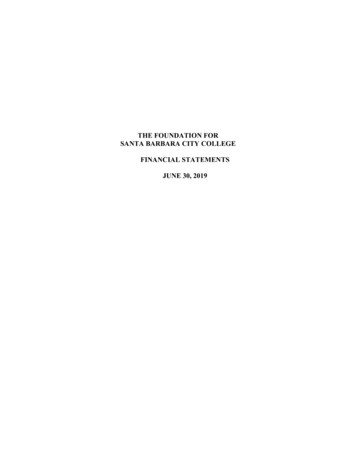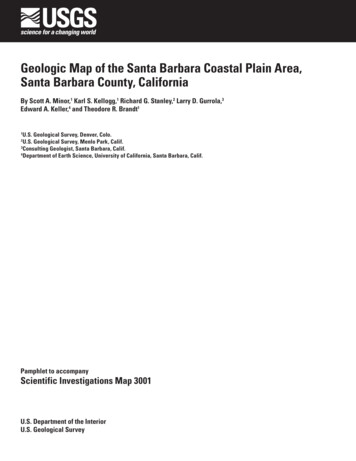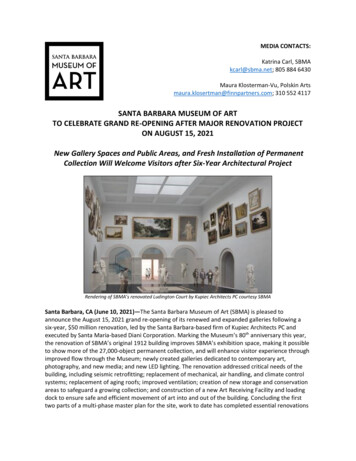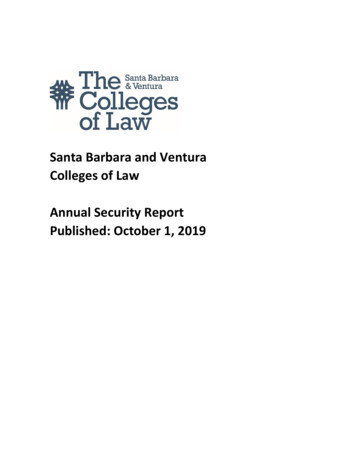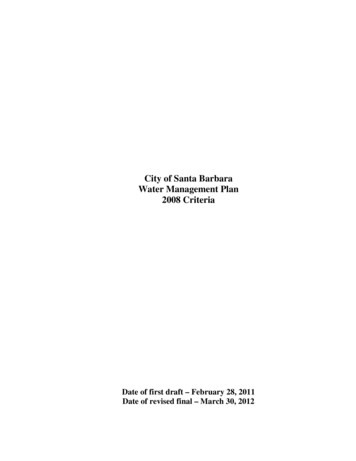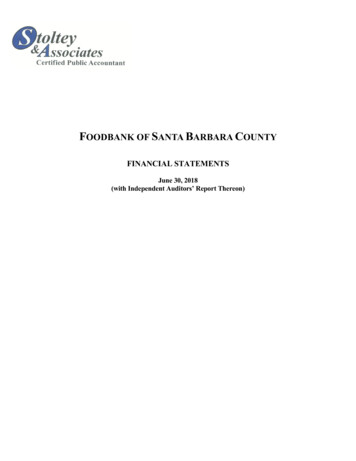
Transcription
UCSB Heat Illness Prevention Program ManualPage 1 of 20UC Santa BarbaraHeat Illness PreventionProgram ManualRev. January 2018Program Manager: Jesse BickleyTitle: Industrial Hygiene Program ManagerEmail: bickley@ucsb.eduPhone: (805) 893-8787UCSB Environmental Health and Safety Industrial Hygiene Heat Illness Prevention ProgramPhone: 805-893-8787 www.ehs.ucsb.edu MC 5132
UCSB Heat Illness Prevention Program ManualPage 2 of 20Table of ContentsI.Purpose/Introduction . 3II.Applicability/Scope . 3III.Responsibilities . 3Departments. 3Supervisors . 3Employees . 4Environmental, Health and Safety (EH&S) . 4A.B.C.D.IV.Definitions . 4V.A.B.C.Types of Heat Illness, Risk Factors and At Risk Employees . 5Types of Heat Illness and First Aid . 5Personal and Environmental Risk Factors . 7At Risk Employees . 8A.B.C.D.Heat Illness Prevention Procedures . 8Heat Illness Prevention Plan . 8Heat Illness Prevention Measures . 9Emergency Response Procedures . 10High Heat Procedures . 11VII.A.B.C.Training Requirements . 12General Heat Illness Training Requirements . 12Additional Supervisor Heat Illness Training . 13Training Resources . 13VIII.A.Record Keeping Requirements . 14Training . 14IX.References and Resources . 14X.Issued By and Next Review Date . 14VI.XI.A.B.C.Attachments . 14UCSB Heat Illness Prevention Program Checklist . 15UCSB Campus Heat Illness Prevention Plan . 18Worksite Specific Heat Illness Prevention Plan . 192
UCSB Heat Illness Prevention Program ManualPage 3 of 20I. Purpose/IntroductionThe purpose of the UCSB Heat Illness Prevention Program is to prevent heat related illnessfrom occurring through education and proper work practices. This program also teachesindividuals how to recognize the signs and symptoms of heat illness, and how to respond shouldheat related illness occur. Heat related illness is a serious medical condition that results whenthe body is unable to cool itself sufficiently through sweating. Both personal and environmentalfactors can contribute to the likelihood of developing heat related illnesses which include heatstress, heat exhaustion and ultimately, heat stroke. Heat stroke can be fatal, especially ifmedical treatment is delayed.This program was written to comply with Cal/OSHA regulations for Heat Illness Prevention(CCR, Title 8, Section 3395).II. Applicability/ScopeThe UCSB Heat Illness Prevention Program, through the requirements described in this manual,establishes procedures and responsibilities for UCSB students, faculty, staff and volunteerswhile engaged in University related activities. This program applies to all Departments withoutdoor worksites, and indoor worksites where it could be reasonably anticipated that heatrelated illness could occur (e.g. kitchens, boiler rooms, etc.). The Heat Illness PreventionStandard (CCR, Title 8, Section 3395) requires all employers with outdoor worksites to takecertain steps which have been outlined in this document, to prevent heat illness.III. ResponsibilitiesA. Department Heads and ChairsDirectors and Department Chairs are responsible for: Providing the necessary resources to ensure the health and safety of their employees;Identifying individuals as supervisors and ensuring they are trained on their health andsafety responsibilities;Ensuring departmental compliance with campus health and safety policies andprocedures;Ensuring hazards workplace hazards are identified and controlled.B. Managers, Supervisors, and Principal InvestigatorsSupervisors of employees who perform outdoor work, or indoor work where heat related illnesscould reasonably be anticipated to occur, are responsible for: Ensuring their units understand and comply with the requirements of this program;Ensuring that there is a written Heat Illness Prevention Plan that covers each outdoorworksite they are responsible for (see Attachment B&C);Developing and implementing procedures to comply with the requirement of thisprogram as needed;Ensuring employees have completed documented Heat Illness Prevention training;Being aware of risk factors that contribute to heat illness;Reducing the risk of heat illness by taking special precautions when necessary;Being alert for the signs and symptoms of heat illness in employees;Allowing employees acclimate to working in hot conditions;Making sure employees working in hot conditions are accounted for at the end of thework shift;3
UCSB Heat Illness Prevention Program Manual Page 4 of 20Ensuring employees have access to potable drinking water at all times;Ensuring employees have the necessary Personal Protective Equipment to reduce heatstress (sun hats, light colored clothing, etc.) when needed;Monitoring weather conditions and implement High-heat Procedures when temperaturesequal or exceed 95 degrees Fahrenheit;Ensuring procedures for contacting emergency medical services are in place, and ifnecessary, arrange for the transportation of employees to a point where they can bereached by an emergency medical provider;Knowing what to do and how to summon emergency responders should a heat illnessemergency occur.C. Employees, Students and VolunteersEmployees, Students and Volunteers are responsible for: Understanding and complying with campus health and safety policies and procedures;Notifying their supervisor or EH&S about any hazardous conditions observed on theworksite;Informing their supervisors of any factors that may increase their risk of heat relatedillness;Reporting the signs or symptoms of heat illness in themselves, or others, to theirsupervisor or EH&S immediately.D. Environmental, Health and Safety (EH&S)The UCSB Heat Illness Prevention Program is administered by EH&S. EH&S will function as atechnical resource to departments and will assist them in carrying out their responsibilities asnecessary. Specifically, EH&S is responsible for: Developing and maintaining the UCSB Heat Illness Prevention Program and ensuring itmeets all applicable regulatory requirements;Developing and providing Heat Illness Prevention training.Updating the UCSB Heat Illness Prevention Program and other written materials asregulations or University requirements change.IV. DefinitionsAcclimatization - means temporary adaptation of the body to work in the heat that occursgradually when a person is exposed to it. Acclimatization peaks in most people within four tofourteen days of regular work for at least two hours per day in the heat.Environmental Risk Factors - means working conditions that create the possibility that heatillness could occur, including air temperature, relative humidity, radiant heat from the sun andother sources, conductive heat sources such as the ground, air movement, workload severityand duration, protective clothing and personal protective equipment worn by employees.Heat Illness - means a serious medical condition resulting from the body's inability to cope witha particular heat load, and includes heat cramps, heat exhaustion, heat syncope and heatstroke.Heat Wave - means any day in which the predicted high temperature for the day will be at least80 degrees Fahrenheit and at least ten degrees Fahrenheit higher than the average high dailytemperature in the preceding five days.4
UCSB Heat Illness Prevention Program ManualPage 5 of 20Personal Risk Factors - means factors such as an individual's age, degree of acclimatization,health, water consumption, alcohol consumption, caffeine consumption, and use of prescriptionmedications that affect the body's water retention or other physiological responses to heat.Shade - means blockage of direct sunlight. Shade is considered sufficient when objects do notcast a shadow in the area of blocked sunlight. Shade is not adequate when heat in the area ofshade defeats the purpose of shade, which is to allow the body to cool. For example, a carsitting in the sun does not provide acceptable shade to a person inside it, unless the car isrunning with air conditioning. Shade may be provided by any natural or artificial means as longas it does not expose employees to unsafe or unhealthy conditions, or deter or discourageaccess or use.Temperature - means the dry bulb temperature in degrees Fahrenheit obtainable by using athermometer to measure the outdoor temperature in an area where there is no shade. While thetemperature measurement must be taken in an area with full sunlight, the bulb or sensor of thethermometer should be shielded while taking the measurement, e.g., with the hand or someother object, from direct contact by sunlight.V. Types of Heat Illness, Risk Factors and At Risk EmployeesA. Types of Heat Illness and First AidThere are several types of heat-related illness. The following sections will explain thesymptoms, causes and first aid procedures for each type of heat-related illness. All signs orsymptoms of heat illness should be reported to a supervisor immediately. If a supervisorobserves, or any employee reports, any signs or symptoms of heat illness in an employee, thesupervisor shall take immediate action commensurate with the severity of the illness. If the signsor symptoms are indicators of severe heat illness (such as, but not limited to, decreased level ofconsciousness, staggering, vomiting, disorientation, irrational behavior or convulsions),emergency response procedures shall be implemented. An employee exhibiting signs orsymptoms of heat illness shall be monitored and shall not be left alone or sent home withoutbeing offered onsite first aid and/or being provided with emergency medical services.Heat StrokeHeat stroke is the most serious heat-related disorder. It occurs when the body becomes unableto control its temperature; the body's temperature rises rapidly, the sweating mechanism fails,and the body is unable to cool down. When heat stroke occurs, the body temperature can rise to106 degrees Fahrenheit or higher within 10 to 15 minutes. Heat stroke can cause death orpermanent disability if emergency treatment is not given.Heat Stroke Symptoms: Hot, dry skin or profuse sweatingHallucinationsChillsThrobbing headacheHigh body temperatureConfusion/dizzinessSlurred speechHeat Stroke First Aid: Contact emergency medical services and notify supervisor.5
UCSB Heat Illness Prevention Program Manual Page 6 of 20Move the individual to a cool, shaded or air conditioned area.Cool the individual using methods such as:o Loosening or removing clothingo Soaking their clothes with water.o Spraying, sponging, or showering them with water.o Fanning their body.Heat ExhaustionHeat exhaustion is the body's response to an excessive loss of water and salt, usually throughexcessive sweating. Workers most prone to heat exhaustion are those that are elderly, havehigh blood pressure, and those working in a hot environment.Heat Exhaustion Symptoms: Heavy sweatingExtreme weakness or fatigueDizziness, confusionNauseaClammy, moist skinPale or flushed complexionMuscle crampsSlightly elevated body temperatureFast and shallow breathingHeat Exhaustion First Aid: Contact emergency medical services and notify supervisor.Move individual to a cool, shaded or air conditioned area and allow them to rest.Encourage individual to drink water or other cool, nonalcoholic and non-caffeinatedbeverages.Cool the individual using methods such as:o Loosening or removing clothingo Soaking their clothes with water.o Spraying, sponging, or showering them with water.o Fanning their body.Heat SyncopeHeat syncope is a fainting (syncope) episode or dizziness that usually occurs with prolongedstanding or sudden rising from a sitting or lying position. Factors that may contribute to heatsyncope include dehydration and lack of acclimatization.Heat Syncope Symptoms: Light-headednessDizzinessFaintingHeat Syncope First Aid: Contact emergency medical services and notify supervisor.Have individual sit or lie down in a cool, shaded or air conditioned area and allow themto rest.Encourage individual to drink water or other cool, nonalcoholic and non-caffeinatedbeverages.6
UCSB Heat Illness Prevention Program ManualPage 7 of 20Heat CrampsHeat cramps usually affect workers who sweat a lot during strenuous activity. This sweatingdepletes the body's salt and moisture levels. Low salt levels in muscles causes painful cramps.Heat cramps may also be a symptom of heat exhaustion.Heat Cram Symptoms: Muscle pain or spasms usually in the abdomen, arms, or legs.Heat Cramp First Aid: Stop all activity, and sit in a cool place.Drink clear juice or a sports beverage.Do not return to strenuous work for a few hours after the cramps subside becausefurther exertion may lead to heat exhaustion or heat stroke.Seek medical attention if any of the following apply:o The worker has heart problems.o The worker is on a low-sodium diet.o The cramps do not subside within one hour.Heat RashHeat rash occurs when sweat ducts become clogged and the sweat can't get to the surface ofthe skin. Instead, it becomes trapped beneath the skin's surface causing a mild inflammation orrash.Heat Rash Symptoms: Heat rash looks like a red cluster of pimples or small blisters.It is more likely to occur on the neck and upper chest, in the groin, under the breasts,and in elbow creases.Heat Rash First Aid: Work in a cooler, less humid environment when possible.Keep the affected area dry.Dusting powder may be used to increase comfort.B. Personal and Environmental Risk FactorsThere are a number of factors that can increase the likelihood of an individual experiencing heatrelated illness. Often heat illness is a result of a combination of environmental and personal riskfactors.Environmental Risk FactorsEnvironmental risk factors are working conditions that increase the likelihood of a personexperiencing heat related illness. They include: Warm temperaturesHigh humidityDirect exposure to the sun or other heat sourcesLimited air movementPersonal Risk FactorsPersonal factors affect how well an individual responds to heat. They include:7
UCSB Heat Illness Prevention Program Manual Page 8 of 20Age, weight, and physical conditionDegree of acclimatizationConsumption of water, alcohol, drugs and caffeineUse of medications that affect tolerance to heatJob Related Risk FactorsAn individual’s job duties may increase the likelihood of experiencing heat related illness, suchas: Physical exertion and durationProtective clothing and protective equipment worn by employeesC. At Risk EmployeesAlthough UCSB typically enjoys a mild climate, there are times when environmental conditionsmay increase the risk of heat related illness. The following are examples of groups ofemployees who may be susceptible to these conditions: VI.Athletics StaffDelivery PersonnelEmergency Response PersonnelEvents StaffFacilities Management EmployeesField ResearchersGroundskeepersHazardous Materials WorkersKitchen StaffHousing Services EmployeesNatural Reserve System EmployeesParking Services EmployeesPolice OfficersTransportation Services EmployeesOther individuals not listed who work outdoors, or in indoor areas where heat stress islikely to occur (kitchens, boiler rooms, etc.).Heat Illness Prevention ProceduresDepartments and their supervisors are responsible for developing, implementing, andmaintaining, effective procedures to reduce the risk of heat related illness. These procedures shallbe in writing and include specific heat illness prevention measures and emergency responseprocedures for each worksite location. Supervisors and employees should review theirprocedures on a regular basis, and update them as needed. Environmental, Health & Safety(EH&S) is available, upon request, to help evaluate job tasks, procedures and environmentalconditions.A. Heat Illness Prevention PlanA Heat Illness Prevention Plan shall be developed and implemented at each outdoor worksite,and indoor worksites, where it could be reasonably anticipated that heat related illness couldoccur. The plan shall be in writing in both English and the language understood by the majorityof the employees and shall be made available at the worksite to employees and to8
UCSB Heat Illness Prevention Program ManualPage 9 of 20representatives of the Division upon request. The Heat Illness Prevention Plan at a minimumshall contain: Procedures for the provision of water and access to shade;Acclimatization procedures;Emergency Response Procedures;High heat procedures, where applicable.To assist Departments and Supervisors in meeting these requirements EH&S has developedthe UCSB Campus Heat Illness Prevention Plan (Attachment B) which covers most on-campusworksites, and a Worksite Specific Heat Illness Prevention Plan Worksheet (Attachment C) foroff-campus locations and other locations not adequately covered by the campus plan.Supervisors must ensure that there is a written Heat Illness Prevention Plan for each worksiteunder their responsibility, and employees covered by the plan have review it and are trained onits procedures prior to commencing outdoor work.B. Heat Illness Prevention MeasuresSupervisors are responsible for developing procedures for the following measures and ensuringthey are implemented, as appropriate, to help prevent heat illness among employees:Monitor Weather ConditionsSupervisors are responsible for monitoring weather conditions and scheduling workappropriately. All employees shall be closely observed by a supervisor or designee during aheat wave. Make sure to monitor the weather at the specific location(s) where work activities areoccurring. Prior to each workday, have a designated person check the weather forecast in theareas of work activities. The weather can be monitored by using local radio and televisionstations, websites, and electronic or other devices. See the References and Resources sectionfor some specific weather monitoring resources.Work SchedulingThere is no absolute temperature cutoff, below which, heat illness ceases to be a risk. Heavywork conducted in high humidity, especially if workers are wearing protective clothing or are notacclimated, can present a risk even at ambient temperatures of 70 F or below. Wheneverpossible, schedule outdoor work during cooler times of the day to reduce the risk of heat illness.AcclimatizationAcclimatization is a process by which the body adjusts to increased heat exposure. Employeesare more likely to develop heat related illness if they not allowed or encouraged to take it easywhen a heat wave strikes, or when they start a new job that exposes them to heat. Cal/OSHAreported that 80% of the heat illness cases investigated in 2005 involved employees that hadbeen on the job for fewer than 4 days; 46% of the incidents occurred on the worker’s first day onthe job. Acclimatization is fully achieved in most people within 4 to 14 days of regular workinvolving at least 2 hours per day in the heat.Drinking WaterSupervisors shall ensure employees have access to potable drinking water at all times. Drinkingwater shall be fresh, pure, suitably cool, and provided to employees free of charge. The watershall be located as close as practicable to the areas where employees are working. Wheredrinking water is not plumbed or otherwise continuously supplied, it shall be provided insufficient quantity at the beginning of the work shift to provide one quart per employee per hour9
UCSB Heat Illness Prevention Program ManualPage 10 of 20for drinking for the entire shift. Employers may begin the shift with smaller quantities of water ifthey have effective procedures for replenishment during the shift as needed to allow employeesto drink one quart or more per hour. The frequent drinking of water shall be encouraged.Rest BreaksEmployees shall be allowed and encouraged to take a preventative cool-down rest in the shadefor a period of no less than five minutes at a time when they feel the need to do so to protectthemselves from overheating. An individual employee who takes a preventative cool-down rest(A) shall be monitored and asked if he or she is experiencing symptoms of heat illness; (B) shallbe encouraged to remain in the shade; and (C) shall not be ordered back to work until any signsor symptoms of heat illness have abated, but in no event less than 5 minutes in addition to thetime needed to access the shade.ShadeSupervisors shall ensure shade is available to their employees when the temperature exceeds 80degrees Fahrenheit, and upon employee request when temperatures are below 80 degreesFahrenheit. When the outdoor temperature in the work area exceeds 80 degrees Fahrenheit, theemployer shall have and maintain one or more areas with shade at all times while employees arepresent that are either open to the air or provided with ventilation or cooling. The amount of shadepresent shall be at least enough to accommodate the number of employees on recovery or restperiods, so that they can sit in a normal posture fully in the shade without having to be in physicalcontact with each other. The shade shall be located as close as practicable to the areas whereemployees are working. Subject to the same specifications, the amount of shade present duringmeal periods shall be at least enough to accommodate the number of employees on the mealperiod who remain onsite.TrainingDocumented Heat Illness Training covering the requirements in Section VII of this document shallbe provided to all applicable workers before they begin work in hot environments.Employee MonitoringSupervisors should continuously monitor employees closely for signs and symptoms of heatillness. During heat waves and with new employees, supervisors must be extra-vigilant. Allemployees shall be closely observed by a supervisor or designee during a heat wave. A “heatwave” means any day in which the predicted high temperature for the day will be at least 80degrees Fahrenheit and at least ten degrees Fahrenheit higher than the average high dailytemperature in the preceding five days. An employee who has been newly assigned to a highheat area shall be closely observed by a supervisor or designee for the first 14 days of theemployee's employment.C. Emergency Response ProceduresAs part of their written Heat Illness Prevention Plan, departments and supervisors shall developand implement effective worksite emergency response procedures. Emergency responseprocedures shall include:1. How effective communication by voice, observation, or electronic means will bemaintained so that employees at the work site can contact a supervisor or emergencymedical services when necessary. An electronic device, such as a cell phone or textmessaging device, may be used for this purpose only if reception in the area is reliable.10
UCSB Heat Illness Prevention Program ManualPage 11 of 20If an electronic device will not furnish reliable communication in the work area, theemployer will ensure a means of summoning emergency medical services.2. How to respond to signs and symptoms of possible heat illness, including but not limitedto first aid measures and how emergency medical services will be provided.3. How to contact emergency medical services and, if necessary, how employees will betransported to a place where they can be reached by an emergency medical provider.4. How in the event of an emergency, clear and precise directions to the work site can andwill be provided as needed to emergency responders.In non-remote areas throughout the United States, emergency medical services are generallyavailable by calling 911. Supervisors are to ensure that employees are able to provide clearconcise directions to their worksite. In remote field locations, developing procedures foremergency medical services may require extensive planning, and supervisors must ensureemployees are informed of exactly how and where medical attention may be received. Alwaysmake sure employees have communication means and knowledge of how to guide emergencyservices to their location.If a supervisor observes, or any employee reports, any signs or symptoms of heat illness in anemployee, the supervisor shall take immediate action commensurate with the severity of theillness. If the signs or symptoms are indicators of severe heat illness (such as, but not limited to,decreased level of consciousness, staggering, vomiting, disorientation, irrational behavior orconvulsions), emergency response procedures shall be implemented. An employee exhibitingsigns or symptoms of heat illness shall be monitored and shall not be left alone or sent homewithout being offered onsite first aid and/or being provided with emergency medical services.Supervisors must reiterate to all employees the importance of immediately reporting anysymptoms or signs of heat illness in themselves or co-workers and remind employees what todo in case emergency medical treatment is needed.On-campus procedures for responding to heat illness: Dial 893-3446 for campus police dispatch or 911 (9-911 from a campus phone) foremergency medical help;Tell the dispatcher this is a heat related illness;Provide information on the exact location of the incident using maps and buildinginformation which are readily displayed around campus if necessary.Provide first aid to victim until emergency responders arriveNotify your supervisor and contact UCSB Workers’ Compensation at 893-4440D. High-heat ProceduresHigh-heat procedures are only required for workers who perform jobs in the industries listedbelow. However, it is recommended that similar procedures be implemented for non-requiredindustries to reduce the risk of heat related illness whenever possible. AgricultureConstructionLandscapingOil and gas extractionTransportation or delivery of agricultural products, construction materials or other heavymaterials (e.g. furniture, lumber, freight, cargo, cabinets, industrial or commercialmaterials), except for employment that consists of operating an air-conditioned vehicleand does not include loading or unloading.11
UCSB Heat Illness Prevention Program ManualPage 12 of 20Supervisors of employees that fall under the categories list above shall implement high-heatprocedures when the temperature equals or exceeds 95 degrees Fahrenheit. These proceduresmust include the following to the extent practicable:1. Scheduling work during the cooler hours of the day, or if possible postponing work untilambient temperatures decrease.2. Ensuring that effective communication by voice, observation, or electronic means ismaintained so that employees at the work site can contact a supervisor when necessary.An electronic device, such as a cell phone or text messaging device, may be used forthis purpose only if reception in the area is reliable.3. Remind employees throughout the work shift to drink plenty of water.4. Designating one or more employees on each worksite as authorized to call foremergency medical services, and allowing other employees to call for emergencyservices when no designated employee is available.5. Pre-shift meetings before the commencement of work to review the high heatprocedures, encourage employees to drink plenty of water, and remind employees oftheir right to take a cool-down rest when necessary.6. Observing employees for alertness and signs or symptoms of heat illness. The employershall ensure effective employee observation/monitoring by implementing one or more ofthe following:a. Supervisor or designee observation of 20 or fewer employees, orb. Mandatory buddy system, orc. Regular communication with sole employee such as by radio or cellular phone, ord. Other effective means of observation.7. For employees employed in agriculture, the following shall also apply: Whentemperatures reach 95 degrees or above, the employer shall ensure that the employeetakes a minimum ten minute net preventative cool-down rest period every two hours.The preventative cool-down rest period required by this paragraph may be p
UCSB Heat Illness Prevention Program Manual Page 6 of 20 6 Move the individual to a cool, shaded or air conditioned area. Cool the individual using methods such as: o Loosening or removing clothing o Soaking their clothes with water. o Spraying, sponging, or showering them with water. o Fanning their body. Heat Exhaustion Heat exhaustion is the body's response to an excessive loss of water and .
